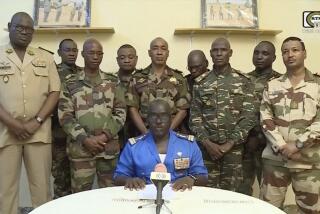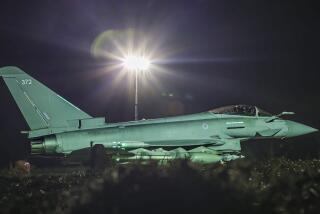Vast new intelligence haul fuels next phase of fight against Islamic State
U.S. intelligence analysts have gained valuable insights into Islamic State’s planning and personnel from a vast cache of digital data and other material recovered from bombed-out offices, abandoned laptops and the cellphones of dead fighters in recently liberated areas of Iraq and Syria.
In the most dramatic gain, U.S. officials over the last two months have added thousands of names of known or suspected Islamic State operatives to an international watch list used at airports and other border crossings. The Interpol database now contains about 19,000 names.
The intelligence haul — the largest since U.S. forces entered the war in mid-2014 — threatens to overwhelm already stretched counter-terrorism and law enforcement agencies in Europe, where Islamic State has claimed responsibility for attacks in Paris, London and Stockholm this year.
With the extremist group’s army and self-declared caliphate fast shrinking, U.S. officials are concerned that foreign-born militants who once flocked to Iraq and Syria will try to escape before the U.S.-led coalition or other military forces can kill them.
In recent weeks, U.S.-backed ground forces have sent an estimated 30 terabytes of data — equal to nearly two years of nonstop video footage — to the National Media Exploitation Center in Bethesda, Md., a little-known arm of the Pentagon’s Defense Intelligence Agency, according to officials who spoke on condition of anonymity to discuss the intelligence.
Analysts there are scrutinizing handwritten ledgers, computer spreadsheets, thumb drives, mobile phone memory cards and other materials for clues to terrorist cells or plots in Europe or elsewhere.
“The reason electronic exploitation is so critical is that enemy forces doesn’t fake those records,” an intelligence official said. “When you interrogate someone they can hide facts, but logs of phone calls and video clips don’t lie. That stuff isn’t made-up.”
The material came from Mosul, the militants’ self-declared capital in Iraq, which was recaptured July 9 after an eight-month battle. Other intelligence was found in the Iraqi city of Tal Afar, which was retaken on Aug. 31, and from Raqqah, the group’s self-declared capital in Syria, where fighting is still underway.
“We’ve gotten significant amounts of intelligence as a result of the fall of these places — much is still being analyzed,” Defense Secretary James N. Mattis told The Times during a visit to Amman, Jordan, last month. “It has helped us to identify at least some of their aspirations.”
U.S. officials said they have gleaned planning ideas and outlines of potential operations rather than ongoing terrorist plots. But they also have gathered details into the group’s leadership and the hierarchy of fighters under command.
The biggest windfall came from what officials said were meticulous Islamic State records about the foreign fighters who arrived since convoys of black-flagged militants first stormed out of northern Syria and into Iraq in 2014, capturing large parts of both countries and the world’s attention.
The records include their names, aliases, home countries and other personal information.
The data has been shared with a 19-nation task force in Jordan, code-named Operation Gallant Phoenix, that tries to track foreign fighters in an effort to disrupt terrorist cells and networks. The task force is led by the U.S. military’s clandestine Joint Special Operations Command.
“If we find information about foreign fighters from a certain country, we go through proper procedures to make sure it’s shared,” said Brett McGurk, the special presidential envoy for the global coalition to defeat Islamic State. President Obama appointed McGurk in 2015 and President Trump has kept him on.
“So it is a very comprehensive campaign, militarily, on the ground, taking territory back; collecting information; processing it; and then building the database and the system so it can be shared and acted upon,” McGurk said in Amman.
With few U.S. troops on the ground, most of the intelligence is gathered by Iraqi security forces and U.S.-backed Syrian militias who have been trained to gather, bag and tag material to be analyzed back in the states.
A phone from the pocket of a dead fighter often includes phone numbers that can assist counter-terrorism investigations far afield. Indeed, intelligence recovered from the battlefield since 2015 has led to arrests or broken up plots in at least 15 countries in Europe, the Middle East, Southeast Asia, Africa, Latin America and Canada, officials said.
Matthew Levitt, a former counter-terrorism official at the FBI and Treasury Department now with the nonpartisan Washington Institute for Near East Policy, said obtaining an alias, driver’s license, passport number or biometric data can be crucial to blocking a terrorist plot.
“Time and again, we’ve found that even the smallest bit of information can prove critical,” he said. “It could help us discover a person we never knew about or provide new leads on an underground cell.”
U.S. officials say Islamic State has lost 60% of the territory it captured in 2014, and its force has been halved to about 15,000 fighters. The recent intelligence indicates that they are concentrating forces and shifting their operations base to the Middle Euphrates River Valley, which lies between Iraq and Syria.
An estimated 8,000 fighters have moved to the valley, which stretches more than 150 miles from Deir el Zour in eastern Syria down to Rawa in western Iraq. They include most of the group’s leaders and their families, as well as key aides for administrative functions.
A U.S. special operations task force tracked and killed three leaders, who allegedly oversaw weapons research and drone operations, in the valley this week, officials said. In all, more than 35 military commanders, weapons production experts, financial facilitators and external attacks plotters have been killed there in the past year.
Islamic State founder Abu Bakr Al Baghdadi is believed to be hiding in the area, said Lt. Gen. Stephen Townsend, who completed his tour this month as top commander of U.S. forces in Iraq and Syria. He predicted the militants would make their “last stand” in the valley.
“That’s where they believe their last sanctuary is,” he told reporters on Aug. 31.
Jennifer Cafarella, a Syria analyst at the nonpartisan Institute for the Study of War in Washington, warned that the battle is far from over. Islamic State’s leadership ranks have proven resilient and its harsh Islamist message continues to find an audience among disaffected youth.
“The noose is tightening, so to speak, but these guys don’t quit,” she said. “The remaining terrain won’t be taken quickly or easily. And even when it is taken, there’s no guarantee that accomplishment will mark the end.”
Twitter: @wjhenn
ALSO:
U.S. special operations forces face growing demands and increased risks
The U.S. is launching ‘danger-close’ drone strikes so risky they require Syrian militia approval
More to Read
Start your day right
Sign up for Essential California for news, features and recommendations from the L.A. Times and beyond in your inbox six days a week.
You may occasionally receive promotional content from the Los Angeles Times.







